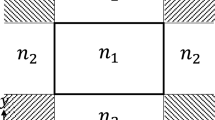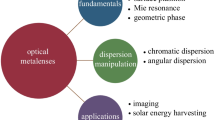Abstract
A search-and-track algorithm is proposed for controlling the number of guided modes of planar optical waveguides with arbitrary refractive index profiles. The algorithm starts with an initial guess point in the parameter space that supports a specific number of guided modes. Then, it searches for, and tracks, the boundaries of this space or another space supporting different number of modes. It does so by monitoring the sign of a unified cutoff dispersion function. The algorithm is applied to both symmetric and asymmetric silicon-based parabolic-index waveguides. It shows that unlike asymmetric waveguides, the single-mode condition of symmetric waveguides is controlled by TM-, as opposed to TE-, polarization. This abnormal polarization control is strongest for high index contrast waveguides of sub-micrometer core sizes. The results are verified by full-vectorial beam propagation method.
Similar content being viewed by others
References
Adams M.J.: An Introduction to Optical Waveguides. Wiley, New York (1981)
Anemogiannis E., Glytsis E.N.: Multilayer waveguides: efficient numerical analysis of general structures. J. Lightw. Technol. 10(10), 1344–1351 (1992)
Chan S.P., Png C.E., Lim S.T., Reed G.T., Passaro V.M.N.: Single-mode and polarization-independent silicon-on-insulator waveguides with small cross section. J. Lightw. Technol. 23(6), 2103–2111 (2005)
Chiang K.S.: Coupled-zigzag-wave theory for guided waves in slab waveguide arrays. J. Lightw. Technol. 10(10), 1380–1387 (1992)
Chung M.-S., Kim C.-M.: General eigenvalue equations for optical planar waveguides with arbitrarily graded-index profiles. J. Lightw. Technol. 18(6), 878–885 (2000)
Delage A., Janz S., Lamontagne B., Bogdanov A., Dalacu D., Xu D.-X., Yap K.P.: Monolithically integrated asymmetric graded and step-index couplers for microphotonic waveguides. Opt. Express 14(1), 148–161 (2006)
Ding H., Chan K.T.: Solving planar dielectric waveguide equations by counting the number of guided modes. IEEE Photon. Technol. Lett. 9(2), 215–217 (1997)
Donnelly J.P., Lau S.D.: Generalized effective index series solution analysis of waveguide structures with positionally varying refractive index profiles. IEEE J. Quantum Electron. 32(6), 1070–1079 (1996)
Ghatak A.K., Thyagarajan K., Shenoy M.R.: Numerical analysis of planar optical waveguides using matrix approach. J. Lightw. Technol. LT-5(5), 660–667 (1987)
Hadley G.R., Smith R.E.: Full-vector waveguide modeling using an iterative finite-difference method with transparent boundary conditions. J. Lightw. Technol. 13(3), 465–469 (1995)
Mashanovich G.Z., Milosevic M., Matavulj P., Stankovic S., Timotijevic B., Yang P.Y., Teo E.J., Breese M.B.H., Bettiol A.A., Reed G.T.: Silicon photonic waveguides for different wavelength regions. Semicond. Sci. Technol. 23(6), 064002, 9pp (2008)
Mehrany K., Rashidian B.: Polynomial expansion for extraction of electromagnetic eigenmodes in layered structures. J. Opt. Soc. Am. B. 20(12), 2434–2441 (2003)
Milosevic M.M., Matavulj P.S., Timotijevic B.D., Reed G.T., Mashanovich G.Z.: Design rules for single-mode and polarization-independent silicon-on-insulator rib waveguides using stress engineering. J. Lightw. Technol. 26(13), 1840–1846 (2008)
Ramadan T.A.: A recurrence technique for computing the effective indexes of the guided modes of coupled single-mode waveguides. Prog. Electromagn. Res. M 4, 33–46 (2008)
Ramaswamy V., Lagu R.K.: Numerical field solution for an arbitrary asymmetrical graded-index planar waveguide. J. Lightw. Technol. LT-1(2), 408–417 (1983)
Ruschin S., Griffel G., Hardy A., Croitoru N.: Unified approach for calculating the number of confined modes in multilayered waveguiding structures. J. Opt. Soc. Am. A 3(1), 116–123 (1986)
Scarmozzino R., Gopinath A., Pregla R., Helfert S.: Numerical techniques for modeling guided-wave photonic devices. IEEE J. Sel. Topics Quantum Electron. 6(1), 150–162 (2000)
Shiraishi K., Tsai C.S.: A micro light-beam spot-size converter using a hemicylindrical GRIN-slab tip with high-index contrast. J. Lightw. Technol. 23(11), 3821–3826 (2005)
Wang L., Huang N.: A new numerical method for solving planar waveguide problems with arbitrary index profiles: TE mode solutions. IEEE J. Quantum Electron. 35(9), 1351–1353 (1999)
Zariean N., Sarrafi P., Mehrany K., Rashidian B.: Differential-transfer-matrix based on Airy’s functions in analysis of planar optical structures with arbitrary index profiles. IEEE J. Quantum Electron. 44(4), 324–330 (2008)
Author information
Authors and Affiliations
Corresponding author
Rights and permissions
About this article
Cite this article
Ramadan, T.A. A search-and-track algorithm for controlling the number of guided modes of planar optical waveguides with arbitrary refractive index profiles. Opt Quant Electron 43, 175–189 (2012). https://doi.org/10.1007/s11082-011-9521-4
Received:
Accepted:
Published:
Issue Date:
DOI: https://doi.org/10.1007/s11082-011-9521-4




